Cite this document
(“Evaluating the Case for Differential Diagnosis between Anxiety Essay”, n.d.)
Retrieved from https://studentshare.org/psychology/1395624-evaluating-the-case-for-differential-diagnosis
Retrieved from https://studentshare.org/psychology/1395624-evaluating-the-case-for-differential-diagnosis
(Evaluating the Case for Differential Diagnosis Between Anxiety Essay)
https://studentshare.org/psychology/1395624-evaluating-the-case-for-differential-diagnosis.
https://studentshare.org/psychology/1395624-evaluating-the-case-for-differential-diagnosis.
“Evaluating the Case for Differential Diagnosis Between Anxiety Essay”, n.d. https://studentshare.org/psychology/1395624-evaluating-the-case-for-differential-diagnosis.


